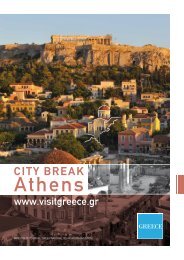Athens
Create successful ePaper yourself
Turn your PDF publications into a flip-book with our unique Google optimized e-Paper software.
City break_6<br />
The Parthenon<br />
The Acropolis Museum - The Parthenon frieze<br />
Start your tour at the temple of Olympian Zeus (6th c.<br />
BCE), one of the largest in antiquity. Right next to it, Hadrian’s<br />
Arch (131 CE) is the symbolic entrance to the city.<br />
From there, walk along Dionyssiou Areopaghitou Street<br />
and pass by the ancient open Theatre of Dionyssos (5th<br />
c. BCE) where the ancient plays of Sophocles, Euripides,<br />
Aeschylos and Aristophanes were performed. After<br />
the ruins of the Asclepieion (5th c. BCE) and the stoa of<br />
Eumenes (2nd c. BCE), visit the Odeion of Herodes Atticus,<br />
the once closed theatre, which was built in 161 CE<br />
and is nowadays the venue of the <strong>Athens</strong> Festival.<br />
From there you can climb up to the sacred rock of Acropolis.<br />
Here you can find some of the most important architectural<br />
and art masterpieces in the world, such as Propylaea,<br />
the temple of Athena Nike and Erechtheion. The<br />
most renowned is the Parthenon temple, built by Callicrates<br />
and Iktinos during the 5th c. BCE and gloriously<br />
decorated by famous sculptor Phidias. Only 300m. away<br />
from the sacred rock of Acropolis stands the impressive<br />
new Acropolis Museum, which houses 4,000 priceless<br />
finds form the Acropolis monuments.<br />
Coming down from Acropolis, you arrive at Areios Pagos,<br />
the most ancient law court in the world. Right opposite,<br />
beautifully cobbled little roads leading to the Roman<br />
monument adorn Philoppapou Hill. Closeby the ancient<br />
Pnyx was the place where Athenians used to assemble<br />
and exert their democratic rights. Walking farther along<br />
the pedestrian road, you arrive at Ancient Agora, the<br />
commercial, political and religious centre of ancient <strong>Athens</strong><br />
and the Temple of Hephaistos, the best-preserved<br />
temple of Greek antiquity. Nearby, you will find Roman<br />
Agora with the famed “Tower of Winds” (1st c. BCE) and<br />
Hadrian’s Library (132 CE).<br />
From there, via Ermou Street, you arrive at Kerameikos,<br />
the largest cemetery of the ancient city, with impressive<br />
tomb sculptures and stelae.<br />
The Philopappou<br />
Monument<br />
The Temple of<br />
Hephaistos<br />
The Roman Agora<br />
The Acropolis Museum







